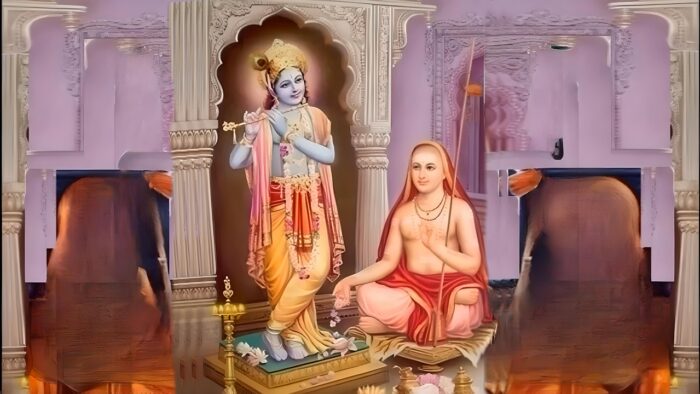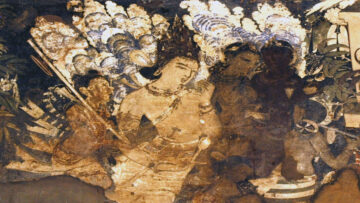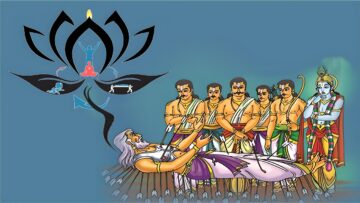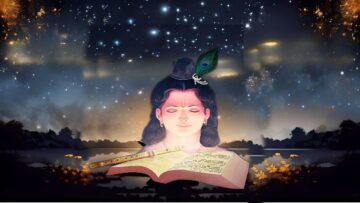The previous article discussed Rule 1- Bhaja Govindam, Live an Ishvara-centric life. We learned that Sri Sankara teaches us to Bhaja Govinda because only by leading a life centered on Govinda can we give this life a purpose.
भज गोविंदं भज गोविंदं भज गोविंदं मूढ़मते ।
संप्राप्ते संन्निहिते काले न हि नहि रक्षति डुकृञ्यकरणे ।। Bh.Go 1
He referred to the bhakti filled reverence as bhaja, which means seva.The verse implied that whatever we do can be converted into bhaja if only we do it with an attitude of seva to Ishvara. A pressing issue for Sri Sankara, as it is for us, is the Jiva’s continual birth and death in Samsara. The only remedy for this is Murari’s Grace (Anugraha).
पुनरपि जननं पुनरपि मरणं पुनरपि जठरॆ शयनम् ।
इह संसारे बहु दुस्तारे कृपयापारे पाहि मुरारे ।।Bh.Go 21
The method of invoking Ishvara’s grace, however, is easier said than done, as explained by Acharya in
गेयं गीता नामसहस्रम् ध्येयं श्रीपति रूपमजस्रम् ।
देयं सज्जनसंगे चित्तं देयं दीनजनाय च वित्तम् ।।Bh.Go 27
Acharya instructs us to use our bodies in dharmic activities such as charity (daana),bhaja (archana), and so on. He directs speech to sing and chant Vishnu Sahasranama, Geeta and to commit the mind to contemplating the Lord’s lovely form.
We must understand that chanting/singing Geeta and Sahasranama does not imply simply chanting and repeating verses. Although chanting has advantages, the true benefits come from feeling the verses and and becoming emotionally engrossed in them. That is why Acharya asks us to study Geeta.
भगवद्गीता किञ्चिदधीता गङ्गा जललवकणिका पीता ।
सकृदपि येन मूरारिसमर्चा क्रियते तस्य यमेन न चर्चा ।। Bh.Go 20
Geeta and Vishnu Sahasranama are both part of the Mahabharata epic. Acharya Sankara has written an authoritative commentary on both. Acharya’s suggestion of these two texts is not coincidental. The Geeta is directed at a Rajasic seeker who is unsure how he should act in the world. The Sahasranama is written for a Sattvik seeker who wants to learn more about Ishvara’s true nature. Both texts are significant because they are rich in both jnana and bhakti. Roopam can be translated as both form and nature. Bhakti reveals the Lord’s beautiful, enchanting form in the Sahasranama through his various names. Jnana reveals Ishvara’s true nature as being non-separate from the seeker himself, as confirmed by the Geeta, which is nothing but a restatement of the Upanishads’ message. Knowing both the form and nature of Ishvara allows one to easily contemplate Him. Vairagya forms an aid to both bhakti and jnana. It is impossible to have either firm bhakti or jnana develop in a mind bereft of at least some vairagya.
Rule 2- Kasya Sukham Na Karoti Viraga (कस्य सुखं न करोति विरागः)
Fake Vairagya
Let us first define what vairagya is not. Vairagya is not leaving home to travel to the Himalayas for uninterrupted meditation. Vairagya is not remaining unaffected by what is going on around you. Vairagya is not giving up all possessions and living as a beggar.
Vairagya is all these things and none of them. Vairagya is a way of looking at life. Vairagya is a refined way of seeing the world. Only those with vairagya can enjoy life; for the rest, despite appearing to be pleasurable, the result is sorrow.
भोगा न भुक्ता वयमेव भुक्ताः तपो न तप्तं वयमेव तप्ताः ।
कालो न यातो वयमेव याताः तृष्णा न जीर्णा वयमेव जीर्णाः ।। vairagya Shatkam-7
“Worldly pleasures have not been enjoyed by us, but we ourselves have been devoured; no religious austerities have been performed, but we ourselves have become scorched; time is not gone (being ever present and infinite), but we ourselves are gone (because of approaching death). Desire is not reduced in force, though we ourselves are reduced to senility.”
To warn us that vairagya is an inner concept rather than an external embellishment, Sri Sankara demonstrates that a person may exhibit all the external signs of being a Viragi, but he may be filled with desires on the inside.
जटिलो मुण्डी लुञ्चितकेशः काषायीम्बरबहुकृतवेषः ।
पश्यन्नपि च न पश्यति मूढो ह्युदरनिमित्तं बहुकृतवेषः ।। Bh.Go 14
“One ascetic with matted locks, one with shaven head, one with hairs pulled out one by one, another parading his ochre robes- these are fools who, though seeing, do not see. Indeed, these different disguises or apparels are only for the belly’s sake.”
Sri Sankara begins with a description of several types of sadhus wearing various types of saffron robes and who may have matted hairs, no hairs, or sadhus who pull out their hair one by one as a tapa. Even though they have perfectly healthy physical eyes capable of seeing the world around them, Acharya warns that they do not see. They lack the inner eye of discrimination because they have used their Sannyasi status to engage in activities that have essentially turned this noble ashrama of life into a profession, like that of a doctor or an engineer.
This verse also serves as a warning to sincere seekers, not to be too quick to judge gurus based on their outward activities. Someone who has the appearance of a vairagi may be overly attached to wealth or fame. A true sannyasi, on the other hand, can be completely detached even in the proximity of all sense objects. This verse instructs us to examine our own attitudes before passing judgement on others.
Sri Sankara also has something to say about the person who has renounced all possessions and lives like a wandering monk. This Sannyasi has no possessions, i.e., no home to live, no bed to sleep in, is at the mercy of nature during summer and winter, does not even have a plate to take the bhiksha in. But Acharya says that even with such physical renunciation, the person may still be tied to a thousand desires in the realm of his mind. The desires may be for gaining various siddhis or even the desire for people to appreciate his desirelessness. No doubt that this Sannyasi has achieved a great deal by renouncing physical necessities of life, but Sri Sankara says that ego and desires can still wreak havoc even within such a sincere seeker.
अग्रे वह्निः पृष्ठे भानुः रात्रौ चुबुकसमर्पितजानुः ।।
करतलभिक्षस्तरूतलवासः तदपि न मुञ्चत्याशापाशः ।। Bh.Go 16
“In front of the fire, at the back the sun, late at night he sits with his knees held to his chin; he receives alms in his own scooped palm and lives under the shelter of some tree, and yet the noose of desires spares him not!”
People believe that they will work for vairagya in their old age. Sri Sankara debunks this myth by demonstrating that old age does not guarantee that vairagya will appear on its own.
अंड्गं गलितं पलितं मुण्डं दशनविहिनं जातं तुण्डम् ।
वृद्धो याति गृहीत्वा दण्डं तदपि न मुञ्चत्याशापिण्डम् ।। Bh.Go 15
“The body has become worn out. The head has turned grey. The mouth has become toothless. The old man moves about leaning on his staff. Even then he leaves not the bundle of his desires.”
दिनयामिन्यौ सायं प्रातः शिशिरवसन्तौ पुनरायातः ।
कालः क्रीडति गच्छत्यायुः तदपि न मुञ्चत्याशावायुः ।। Bh.Go 12
“Day and night, dawn and dusk, winter, and spring, again and again come and depart. Time sports and life ebbs away. And yet, one leaves not the gusts of desires.”
सुखतः क्रियते रामाभोगः पश्चाद्धन्त शरीरे रोगः ।
यद्यपि लोके मरणं शरणं तदपि ननमुञ्चति पापाचरणम् ।। Bh. Go. 28
“Very readily one indulges in carnal pleasures; later, alas, come diseases of the body. Even though in the world the ultimate end is death, even then man leaves not his sinful behavior.”
Real Vairagya
If all this is not real vairagya, then what is real vairagya?
सुरमंदिरतरूमूलनिवासः शय्या भूतलमजिनं वासः ।।
सर्वपरिग्रहभोगत्यागः कस्य सुखं न करोति विरागः ।। Bh.Go 18
“Sheltering in temples, under some trees, sleeping on the naked ground, wearing a deerskin, and thus renouncing all ideas-of-possession and thirst-to-enjoy, to whom will not dispassion bring happiness.”
While the first two lines of this verse indicate the status of a mere physical renouncer, like those described in Bh. Go 14 and 16, the third and fourth lines represent the spiritual renouncer’s status. The third and fourth lines indicate that vairagya is more of a mental state in this context. The Viragi has abandoned his concept of possession and thirst for enjoyment. Is there anything we truly own? Then what is the point of claiming something truly as our own? We only borrow from nature and Ishwara in the same way that we borrow books from a library or from a friend. We claim ownership of objects first, then believe we can enjoy them. But, according to Acharya, only vairagya can truly make us happy. The fount of these ideas is in the Upanishads.
ईशावास्यमिदगँ सर्वं यत्किञच जगत्यां जगत् ।
तेन त्यक्तेन भूञ्जीथा मा गृधः कस्यस्विद्धनम् ।। Isavasya Upanishad-1
“All this, whatever moves in this universe, including those that move not, is indwelt, or pervaded or enveloped or clothed by the Lord. That renounced, thou shouldst enjoy. Covet not anybody’s wealth.”
Because Ishvara pervades everything, like clay pervades a pot, this Jagat is identical to Ishvara. As a result, there is no need to claim ownership of anything we find here. To truly enjoy the Jagat, we must let go of our sense of ownership.
Vairagya is defined by Sri Sankara in Viveka Chudamani as
तद्वैराग्यं जिहासा या दर्शनश्रवणादिभिः ।
देहादिब्रह्मपर्यन्ते ह्यनित्ये भोगवस्तुनि ।। VivekaChudamani-21
“The desire to give up all transitory pleasures gained through seeing, hearing, and so on, as well as experiences gained through equipment ranging from a mortal body to the form of Brahma.”
In Tattva-Bodha, Acharya calls vairagyaas one among the qualifications for a seeker of jnana. इह अमुत्रार्थफल भोग विराग. He then defines it as
विरागः कः? इहस्वर्गभोगेषु इच्छाराहित्यम्। Tattva Bodha-4
“What is dispassion? The absence of the desire for the enjoyments of the fruits of one’s action in this world and heaven.”
There are two kinds of enjoyment, and both are transitory:
- Transitory nature of pleasure in this world (Iha) – These include all the pleasures available to us through sense objects. This one can be termed as secular pleasures, because irrespective of religion and opinion everyone strives for them. The major argumentthat all the shastras unanimously present against these is that since they arise out of contact between impermanent and constantly changing objects and impermanent and constantly changing senses.
- Transitory nature of pleasure in the other world (Amutra) – These include the desire for pleasure beyond the earthly realm. The desire for svarga, and higher lokas, the desire for becoming Indra and Brahma etc. It might appear as if we do not desire these things in the modern world. But a lot of us do good expecting that good will come out of it because we believe in the theory of karma. These heavenly pleasures are nothing but the fructification of our sanchita karmas. They are an extension of the theory of karma into the otherworldly realm.
We need to understand here that desire for gaining pleasure also includes the desire to avoid pain.
Vairagya as a Product of Enquiry
Famous Greek philosopher Socrates said, “An unexamined life is not worth living.”Sri Sankara has always mentioned vairagya coupled with viveka. This shows that vairagya is not just a hate of worldly things but a conclusion that results from a deep examination into the nature of the world.
परीक्ष्य लोकान् कर्मचितान् ब्राह्मणः
निर्वेदमायाद् नास्त्यकृतः कृतेन । Mundaka Upanishad 1.2.12
“Examining the experiences gained by doing actions and meditation, may the discriminative person discover dispassion. Moksha, which is not created, cannot be gained through action.”
This verse asks the seeker to examine the world mentally. The natural conclusion of such an examination would be that anything gained in this world or the other because of karma performed shall come to an end.The Upanishad does not directly jump to vairagya but takes the student onto a journey of examination into the very nature of karma. This enquiry then results in vairagya.
Sri Sankara asks the seeker to enquire deeply into questions such as
Who am I?
From where have I come?
What exactly is your relationship with those you hold near and dear?
का ते कान्ता कस्ते पुत्रः संसारोsयमतीव विचित्रः ।
कस्य त्वं कः कुत आयातः तत्वं चिन्तय तदिह भ्रातः ।। Bh.Go 8
“Who is your wife? Who is your son? Supremely wonderful indeed is this samsara. Of whom are you? From where have you come? O brother, think of that Truth here.”
कस्त्वं कोsहं कुत आयातः का मे जननी को मे तातः ।
इति परिभावय सर्वमसारं विश्वं त्यक्तवा स्वप्नविचारम् ।। Bh.Go 23
“Who are you? Who am I? From where did I come? Who is my mother? Who is my father? Thus enquire, leaving aside the entire world-of-experience, essenceless and a mere dreamland, born of imagination.”
He asks the seeker to view reality as it is. He aptly writes that upon deeper enquiry into the nature of the world as unfolded by Vedanta and other scriptures one will naturally concludethat this Samsara has no independent essence apart from Ishvara. Swami Chinmayananda in his commentary writes aptly “a lump of clay gets attached to another lump of clay.What a wonder of wonders it indeed is.”
Duringthe entire course of Bhaja Govindam, Sri Sankara draws the attention of the seeker into examining various aspects of his life like money, lust, family etc. He willingly magnifies the grotesque and harsh realities so that even a person unwilling to examine life is forced to do so even if for a moment.
Family and Money
यावद्वित्तोपार्जनसक्तस्तावन्निजपरिवारो रक्तः ।
पश्चाज्जीवति जर्जरदेहे वार्तां कोsपि नपृच्छति गेहे ।। Bh.Go 5
“As long as there is ability to earn and save so long are all your dependents attached to you. Later on, when you come to live with an old, infirm body, no one at home cares to speak even a word with you!!”
यावत्पवनो निवसति देहे तावत्पृच्छति कुशलं गेहे ।
गतवति वायौ देहापाये भार्या बिभ्यति तस्मिन्काये ।। Bh.Go 6
“As long as there dwells breath (life) in the body, so long they enquire of your welfare at home. Once the breath (life) leaves, the body decays, even the wife fears the very same body.”
अर्थमनर्थं भावय नित्यं नास्ति ततः सुखलेशः सत्यम् ।
पुत्रादपि धनभाजां भीतिः सर्वत्रैषा विहिता रीतिः ।। Bh.Go 29
“Wealth is calamitous, thus reflect constantly: the truth is that there is no happiness at all to be got from it. To the rich, there is fear ever from one’s own son. This is the way with wealth everywhere.”
Perishability of life
नलिनिदलगतजलमतितरलं तद्वज्जीवितमतिशयचपलम् ।
विद्धि व्याध्यभिमानग्रस्तं लोकं शोकहतं च समस्तम् ।। Bh.Go 4
“The water-drop playing on a lotus petal has an extremely uncertain existence; so also life ever unstable. Understand, the very world is consumed by disease and conceit, and is riddled with pangs.”
Livelihood
मूढजहीहि धनागमतृष्णां कुरूसद्बुद्धिं मनसि वितृष्णाम् ।
यल्लभसे निजकर्मोपात्तं वित्तं तेन विनोदय चित्तम ।। Bh Go 2
“O Fool! Give up the thirst to possess wealth. Create in your mind, devoid of passions, thoughts of the Reality. With whatever you get as a reward of your actions, entertain your mind and be content.”
Lust
नारीस्तनभरनाभीदेशं दृष्टवा मा गा मोहावेश् ।।
एतन्मांवसादिविकारं मनसि विचिंतय वारं वारम् ।। Bh.Go 3
“Seeing the full bosom of young maidens and their navel, do not fall a prey to maddening delusion. This is but a modification of flesh and fat. Think well thus in your mind again and again.”
Conclusion
Sri Sankara thus leads the seeker into an honest examination of himself, the world, and his relationship with the world. With hopes that the seeker will develop sufficient vairagya within himself and with a life centered around Ishvara, Sri Sankara then commits the rest of the verses to his original mission. The mission of delivering jnana to each qualified seeker.
बालस्तावत्क्रीडासक्तः तरूणस्तावत्तरूणीसक्तः ।
वृद्धस्तावच्चिन्तासक्तः परमे ब्रह्मणि कोsपि न सक्तः ।। Bh.Go 7
“So long as one is in one’s boyhood, one is attached to play; so long as one is in youth, one is attached to one’s own young woman; so long as one is in oldage, one is attached to anxiety. Yet no one, Alas to the Supreme Brahman, is ever seen attached!!!!!”
In the next article we shall see how Sri Sankara through his bhaja Govindam tries to show that there is no moksha without jnana and therefore he tries to instill within the seeker a longing to gain jnana.
Disclaimer: The opinions expressed in this article belong to the author. Indic Today is neither responsible nor liable for the accuracy, completeness, suitability, or validity of any information in the article.











